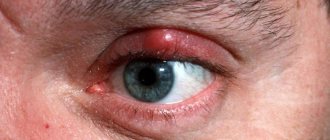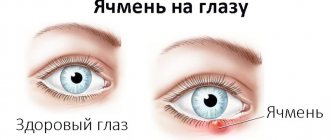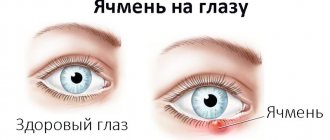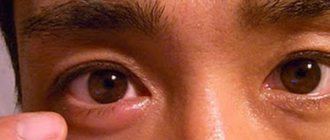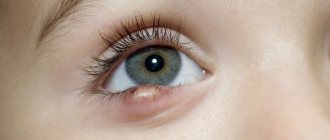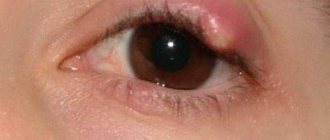Barley (hordeolum) is an infectious inflammation that develops in the sebaceous gland of Zeiss or at the base of the eyelash (hair follicle). Its appearance brings great discomfort, as stye on the eye looks very unattractive and is accompanied by severe pain with any movement of the eyelid.
There is also a variant of internal purulent inflammation - it is formed in the meibomian gland and is visible when the eyelid is pulled back from the inside.
Such a relapse is less common, but as a complication it can lead to a chronic disease of the lower eyelid - chalazion, another name for which is frozen barley.
In this case, most often it is necessary to resort to surgical intervention.
In general, hordeolum is characterized by an unexpected onset and rapid development of inflammation, most often occurring singly.
You cannot treat it as a temporary inconvenience: its occurrence is a clear signal from the body that the immune system is weakened and immediate treatment is required.
Causes
Inflammation of the eyelid mucosa begins after a bacterial infection enters the body. The causative agent is Staphylococcus aureus. Pathogenic bacteria begin to multiply rapidly under favorable conditions.
Provoking factors and reasons for the appearance of stye on the eye:
- weakened immunity due to helminthic infestations, foci of chronic infection;
- furunculosis;
- severe pathologies of the endocrine system (including diabetes mellitus);
- overheating of the body;
- hypothermia;
- prolonged exposure to drafts;
- failure to comply with hygiene rules;
- bad habit of frequently touching the face and eyes;
- colitis, gastritis, other diseases of the digestive system;
- vitamin deficiency;
- malnutrition.
Note! Inflammation of the eye often develops with chronic tonsillitis, sinusitis, hepatitis, sinusitis, cholecystitis, and inflamed adenoids.
Prevention
Despite the fact that inflammation of the eyelid can develop due to hematogenous spread of infection, in most cases, barley occurs when personal hygiene rules are violated. To avoid its occurrence, you should not rub your eyes or touch them with unwashed hands, you must use a separate towel, individual decorative cosmetics, etc.
Another important point for preventing the occurrence of barley is the normalization of immunity and the treatment of chronic diseases.
First symptoms and signs
A ripening stye under the eye makes itself known several hours or even a day before an inflamed tubercle appears on the eyelid. Unpleasant manifestations are familiar to many. More than 80% of the population have experienced inflammation on the eyelids at different periods of life.
Most cases of the disease are observed in children. Barley also appears in men and women aged 35–55 years. The main reason is that during these periods, for various reasons, many people’s immunity decreases.
What does stye look like on the eye? Main symptoms and signs:
- At first, the upper or lower eyelid swells a little;
- pressing on the swollen area causes pain;
- the area next to the tumor becomes slightly red, inflamed, and swollen;
- sometimes the body temperature rises and the head hurts;
- the conjunctiva turns red (not always);
- nearby lymph nodes enlarge;
- An abscess forms in the center of the swollen area.
How long does a stye on the eye last? From several days to several weeks. Sometimes the pus comes out on its own, the papule resolves. More often, the inflammatory process requires treatment.
Remember! By opening the papule, you expose yourself and those who accidentally touch your hands to the risk of further infection. Ulcers contain millions of bacteria. Think about it!
Find out everything about fighting cellulite. Only the most effective methods.
Read more about Dühring's dermatitis herpetiformis at this address.
Varieties of the disease
Foci of infection on the eyelids are:
- single;
- multiple.
Most people develop an abscess in one eye. The spread of the inflammatory process to several hair follicles leads to numerous ulcers in both eyes. This nature of the disease is observed in people with very weak immunity.
Risk categories:
- patients with malignant tumors;
- HIV-infected;
- patients with chronic hepatitis;
- aged people.
Note! The frequency of swelling and papules with purulent contents on the upper and lower eyelids is approximately the same. In severe cases, multiple ulcers develop in both areas. Sometimes the swelling is so great that the upper eyelids droop down, leaving a narrow gap.
Barley is classified according to location:
- outer. Main variety. The molly or Zeiss glands become inflamed. Their function is to produce a secretion that protects the cornea of the eye. The glands are located at the roots of the eyelashes. The fatty secretion produced by the gland clogs the ducts, the eyelid becomes inflamed, swells, and an abscess appears;
- internal stye on the eye. Diagnosed less frequently. The reason is blockage of the internal meibomian glands located deep in the eyelid. Inflammation also develops on the cartilaginous plate of the eyelid. Frequent relapses are evidence of the transition of an infectious disease to the chronic stage.
Note! The internal variety of barley often provokes the development of a “frozen” form - chalazion.
“Cold” stye develops in the absence of proper treatment. Severe cases require surgery.
Treatment methods
Most people dream of quickly getting rid of the abscess, swelling, and redness that worsens their appearance. A half-closed eye does not add attractiveness.
There is stye on the eye, what should I do? You can quickly get rid of barley using simple, effective remedies. An indispensable condition is early initiation of treatment. Suitable:
- traditional methods;
- medications;
- compresses;
- warming up (to the abscess stage).
Contact your ophthalmologist as soon as possible. The doctor will prescribe therapy, taking into account the course of a particular case of the disease.
Application
The cereal is used to make barley and pearl barley , each of which is rich in fiber, vitamins and minerals.
The plant contains a large amount of proteins and carbohydrates, so it is often used as pet food. Barley is used in the following industries :
- cosmetology - smoothes wrinkles, tightens and moisturizes the skin;
- folk medicine - for the treatment of gastrointestinal pathologies (gastritis, colitis, gastric and duodenal ulcers), gynecological diseases, cough, sore throat, high temperature as an antipyretic;
- brewing - as one of the ingredients of an alcoholic drink.
Dishes with the addition of barley or pearl barley have a special taste . Therefore, grain is added to soups and side dishes (especially in kindergartens, schools and medical institutions).
Medications
How to get rid of stye on the eye? Recommended:
- anti-inflammatory eye ointments for stye - Tetracycline, Hydrocortisone;
- treatment of swelling, inflamed tubercle with medicines for barley - brilliant green, ethyl alcohol, calendula tincture;
- eye drops for barley with antibacterial action - Levomycetin, Tsipromed;
- multiple formations, large papules require the use of antibiotics. A test for the sensitivity of pathogens to various drugs is recommended. Levomycetin and Gentamicin tablets are most often prescribed.
Important! Be sure to monitor the progress of treatment with a dermatologist.
We offer you to read an interesting article about atopic dermatitis in children and adults.
Read this article about back lipoma.
If you go here you can find out interesting information about newborn acne.
Folk remedies and recipes
Many people are familiar with this situation: immediately after waking up, suspicions creep in, not unreasonably: “Is it possible that barley is developing?” The first signs appeared: the abscess is not visible, but there is already pain, tingling inside the eyelid, and slight swelling is noticeable. Is it possible to prevent the development of the inflammatory process?
How to remove stye from the eye? There are several proven methods of dealing with this unpleasant phenomenon for treatment at home:
- A simple, affordable method is dry heat. Boil an egg hard, wrap it in a clean cloth or handkerchief, and apply it to the swollen area. Hold until the heat goes away. Instead of eggs, take flax seeds and sea salt. Heat the ingredients in a frying pan and tie them into a knot. Remember - the method is recommended only in the initial stage. It is forbidden to warm up the abscess;
- lotions with calendula. Take 10 g of flowers, 200 ml of boiling water. Keep on fire for 5 minutes, remove and cover the pan with a towel for an hour. Make lotions three times a day;
- Dill compresses are an effective remedy for stye. Rinse a teaspoon of seeds, pour boiling water (250 ml) and boil. Leave for 30 minutes. Apply compresses several times a day;
- aloe lotions. Grind the middle leaf, pour warm boiled water. Keep at room temperature. After a day, strain. Use for lotions. Aloe relieves inflammation well;
- Black tea. Brew strong tea. Apply compresses moistened with infused tea leaves to the affected areas;
- plantain decoction. Dry or fresh leaves - 3 tbsp. l., boiling water - 1 cup. After half an hour, the infusion is ready. Make lotions with plantain decoction daily;
- egg white. Beat well. Lubricate the swelling from the outside;
- anti-inflammatory collection. Supplement external treatment by taking a healing decoction internally. Collection: chamomile, calendula, sage. All herbs in a tablespoon, water - 0.5 liters. Pour boiling water over the raw materials and leave for 30 minutes. Take ¼ cup daily.
Composition and beneficial properties
Barley has a rich chemical composition , see the table for more details.
| Name | Amount of substance in 100 g of product (daily requirement) |
| squirrels | 10,96% |
| fats | 3,48% |
| carbohydrates | 39,44% |
| alimentary fiber | 72,5% |
| vitamin B1 | 28,8% |
| vitamin B2 | 10,3% |
| vitamin B6 | 19,8% |
| a nicotinic acid | 25,8% |
| pantothenic acid | 9,8% |
| magnesium | 35,4% |
| iron | 20,3% |
| selenium | 46,0% |
| phosphorus | 38,6% |
| potassium | 14,6% |
| copper | 51,5% |
The calorie content of 100 g of product is 288 kcal.
Stye on a child's eye
Swelling and ulcers on the eyelids occur much more often in children than in adults. Children pay less attention to hygiene, are more likely to become hypothermic, and have a rather weak immune system.
The symptoms of the infectious disease repeat the features of the development of the inflammatory process in adults. Children often have a fever and their eyelids swell greatly, causing discomfort. The papule on the eye hurts, there is a tingling sensation inside.
Lack of treatment leads to complications. Sometimes vision deteriorates.
What to do if stye appears on the eyelid? Tips for parents:
- consult a doctor as soon as possible;
- At the first sign of inflammation, use dry heat. Check for an abscess. You can warm a reddened, painful area only if there is no papule with pus!
- children do not like unpleasant procedures, come up with a fairy tale about a “magic egg that takes away all diseases with it.” Usually, after such stories, children warm their eyelids with pleasure;
- make lotions with a decoction of chamomile, calendula, and sage.
How to cure stye on a child’s eye:
- Levomycetin, Tetracycline ointment;
- Albucid eye drops;
- taking into account the age of the child, it is possible to use sulfonamides;
- internal stye requires hospitalization;
- in severe, advanced cases, antibiotics are required;
- with internal barley, surgical intervention, removal of pus, and drainage with antiseptic agents are often required.
Advice! For multiple, frequently recurring abscesses on the eyelids, thoroughly examine the child. The same advice applies to adults. Be sure to consult an ophthalmologist and have your blood tested for sugar. Sometimes papules on the eyelids are an indirect sign of diabetes.
Beneficial features
The rich composition of barley makes it a valuable health product . Main properties of cereal:
- activates brain function, strengthens the nervous system;
- improves metabolism;
- reduces blood cholesterol levels;
- gently and carefully cleanses the body of waste and toxins;
- makes the skin elastic and firm;
- slows down the aging process;
- strengthens teeth, bones and nails;
- promotes weight loss and weight maintenance;
- with regular use, it increases immunity and has a general strengthening effect;
- has diuretic, expectorant and anti-inflammatory effects.
A decoction of cereal is used for inflammatory diseases of the gastrointestinal tract.
